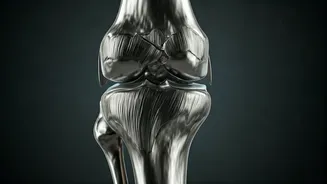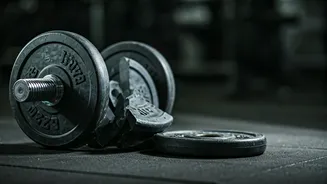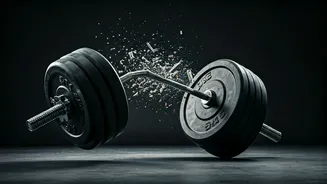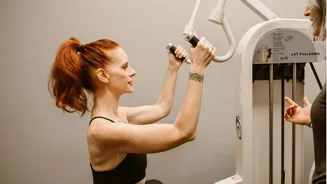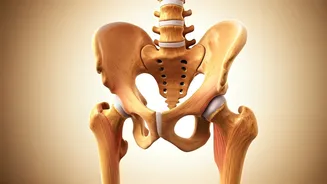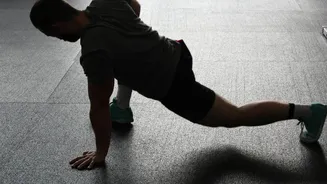Good Mornings Overload
One significant error highlighted by the trainer involves performing good mornings with excessive weight. This exercise, which targets the hamstrings and
glutes, can place undue stress on the lower back when too much weight is used. The improper form is more critical than the amount of weight. When using a weight that's too heavy, individuals often round their backs, which can lead to spinal injuries. The trainer advises starting with a lighter load and focusing on maintaining proper posture throughout the movement. This will ensure that the targeted muscles are engaged and that the joints remain protected. The aim is to build strength and not simply move the weight around.
Knees on Leg Press
Another common mistake is placing hands on the knees while performing leg presses. This often happens when people attempt to push beyond their capabilities. In such a scenario, the form degrades, and the hands get used for extra support. This habit compromises the movement's integrity and can lead to strains. The ideal way to do the leg press involves engaging the core and maintaining a controlled motion. Using the core, instead of the hands on knees, will enhance the effectiveness of the exercise and lower the risk of injury. People should focus on controlling the weight throughout the full range of motion.
Bench Pressing Errors
Incorrect bench press technique is another area of concern. Many people fail to maintain proper form during this exercise, which can strain the shoulders and chest. Common mistakes include arching the back excessively, not retracting the shoulder blades, and lowering the bar too far. These errors often come from ego-lifting, where the lifter prioritizes the weight lifted over the proper execution of the exercise. The trainer advises keeping the shoulders engaged and lowering the bar to the chest with control. Focusing on this will not only improve results but will also safeguard the shoulder and chest joints from potential harm.
Upright Row Problems
Upright rows can be detrimental if performed incorrectly. The problem arises when the lifter pulls the weight too high, often bringing the elbows above the shoulders. This places excessive stress on the shoulder joints and can lead to impingement. To execute this exercise correctly, the trainer suggests pulling the weight towards the chest, while keeping the elbows slightly lower than the shoulders. By doing this, the trapezius muscles will be engaged without putting the shoulders at risk. The correct form guarantees that the muscles get properly worked while keeping the shoulders safe from injury.
Behind-the-Neck Pressing
Behind-the-neck presses also present significant risks. This exercise, which is often performed with a barbell, requires a high level of shoulder mobility. Most people lack this mobility, which causes them to compensate by contorting their bodies and straining their shoulders. The trainer warns against this exercise for those who don't have the proper range of motion. People can consider alternatives that target the same muscle groups without putting the shoulders at risk, such as overhead presses performed with dumbbells or resistance bands. Safety is paramount, and choosing the right exercise is very important.
Shrugs with Terrible Posture
Heavy shrugs with bad posture can be detrimental to the neck and upper back. This is because many individuals tend to round their shoulders forward and use a jerky motion while lifting heavy weights. This places undue stress on the cervical spine and can lead to pain and injury. The trainer suggests maintaining a straight back, retracting the shoulder blades, and using a controlled motion during shrugs. The emphasis should be on contracting the trapezius muscles without compromising form. Doing so will ensure the exercise is effective and the joints remain safe.
Smith Machine Squats
Smith machine squats can be problematic for several reasons. Although the machine provides stability, it also restricts natural movement patterns. This often leads to improper form, as the body is forced into a fixed path. Many users lean forward or don't go deep enough. The trainer recommends using free weights and maintaining balance to enhance the natural movement. This ensures that the muscles are properly engaged. People should start with lighter weights and focus on maintaining good posture. This helps prevent injuries and maximizes muscle development.
Kipping Pull-ups Hazard
Kipping pull-ups, which involve using momentum to assist the upward movement, can be harmful to the shoulder joints. While this exercise can be suitable for advanced users, it can be extremely dangerous for beginners or those with pre-existing shoulder issues. The jerky movements and reliance on momentum can result in tears or strains. The trainer advises practicing strict pull-ups first, focusing on controlled movements and proper form. Using the right technique is essential to building strength and preventing injuries. Avoiding kipping pull-ups unless well-versed is important to avoid joint damage.
